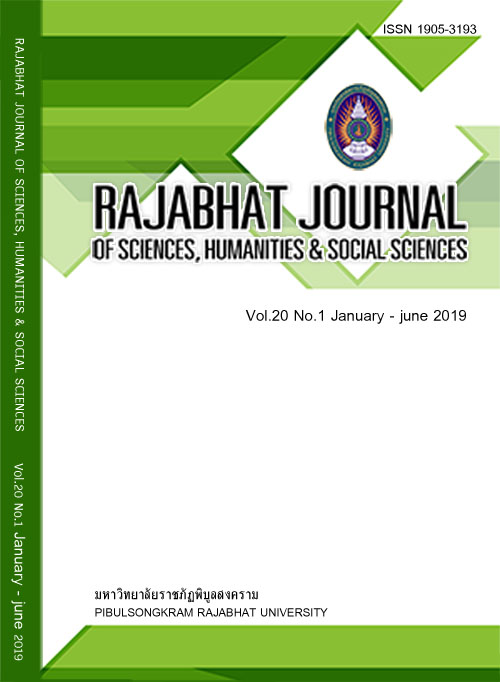DEVELOPMENT OF A FUNCTIONAL FOOD: MILK CHOCOLATE FORTIFIED WITH ANTHOCYANIN FROM BROKEN RICEBERRY
Keywords:
anthocyanin, antioxidant, chocolate, functional food, RiceberryAbstract
The consumption of functional foods, healthier foods, could reduce the risk of non-communication diseases, the major cause of the casualty of the Thai population. Broken Riceberry, an underutilized agricultural byproduct, is rich in anthocyanins, the antioxidants that prevent the diseases. In this study, the anthocyanin-rich extract from broken Riceberry was used as a functional ingredient to produce healthier milk chocolate products. The milk chocolates were prepared by replacing the cocoa powder with the anthocyanin powder (anthocyanin was encapsulated in maltodextrin) by 0 (MC0), 21 (MC21), 42 (MC42) and 70 % w/w (MC70). The total anthocyanin content in the MC21, MC42 and MC70 chocolates increased sequentially (11.1, 83.2 and 107.1 mg cyanidin-3-glucoside equivalent/100 g) with the anthocyanin powder content while it was not detected in MC0. Consequently, the DPPH antioxidant activity of MC0, MC21, MC42, and MC70 respectively increased from 70.7, 72.1, 74.3 to 76.4 %. Maltodextrin, the major constituent in the anthocyanin powder, caused the decrease of the chocolate hardness from 16.6 N (MC0) to the lowest of 9.6 N (MC70). The MC42 received the highest sensory scores (7.0-7.7) for the color, flavor, taste, texture, and overall acceptance attributes. These results indicated that anthocyanin extracted from broken Riceberry could be used as a health benefit functional ingredient for producing healthier foods.
References
Aidoo RP, Afoakwa EO, Dewettinck K. Rheological properties, melting behaviours and physical quality characteristics of sugar-free chocolates processed using inulin/polydextrose bulking mixtures sweetened with stevia and thaumatin extracts. LWT - Food Science and Technology. 2015; 62: 592-597.
Castañeda-Ovando A, Pacheco-Hernández M, Páez-Hernández, et al. Chemical studies of anthocyanins:
A review. Food Chemistry. 2009; 113(4): 859-871.
Ekici L, Simsek Z, Ozturk I, et al. Effects of temperature, time, and pH on the stability of anthocyanin extracts: prediction of total anthocyanin content using nonlinear models. Food Analytical Methods. 2014; 7(6): 1328-1336.
Gallo M, Vinci G, Graziani G. et al. The interaction of cocoa polyphenols with milk proteins studied by proteomic techniques. Food Research International. 2013; 54(1): 406-415.
Giusti MM, & Wrolstad RE. Characterization and measurement of anthocyanins by UV-visible spectroscopy. Current Protocols in Food Analytical Chemistry. New Jersey: John Wiley & Sons; 2001: F1.2.1–F1.2.13.
Gültekin-Özgüven M, Karadağ A, Duman Ş. et al. Fortification of dark chocolate with spray dried black mulberry (Morus nigra) waste extract encapsulated in chitosan-coated liposomes and bioaccessability studies. Food Chemistry. 2016; 201: 205-212.
Hannaneh F, Soleiman A. Effects of inulin and bulking agents on some physicochemical, textural and sensory properties of milk chocolate. Journal of Texture Studies. 2009; 40(5): 536-553.
Hou Z, Qin P, Zhang Y, et al. Identification of anthocyanins isolated from black rice (Oryza sativa L.) and their degradation kinetics. Food Research International. 2013; 50(2): 691-697.
Kalva JJ, Sims CA, Puentes LA, et al. Comparison of the hedonic general labeled magnitude scale with the hedonic 9-point scale. Journal of Food Science. 2014; 79(2): 238-245.
Konar N. Influence of conching temperature and some bulk sweeteners on physical and rheological properties of prebiotic milk chocolate containing inulin. European Food Research and Technology. 2013; 236(1): 135-143.
Laokuldilok T, Kanha N. Effects of processing conditions on powder properties of black glutinous rice (Oryza sativa L.) bran anthocyanins produced by spray drying and freeze drying. LWT - Food Science and Technology. 2015; 64(1): 405-411.
LeongLP, Shui G. An investigation of antioxidant capacity of fruits in Singapore markets. Food Chemistry. 2002; 76(1): 69-75.
Ngamdee P, Wichai U, Jiamyangyuen S. Correlation between phytochemical and mineral contents and antioxidant activity of black glutinous rice bran, and its potential chemopreventive property. Food Technology and Biotechnology. 2016; 54(3); 282-289.
Yousuf B, Gul K, Wani AA, et al. Health benefits of anthocyanins and their encapsulation for potential use in food systems: a review. Critical Reviews in Food Science and Nutrition. 2016; 56(13): 2223-2230.
Downloads
Published
How to Cite
Issue
Section
License
Each article is copyrighted © by its author(s) and is published under license from the author(s).










